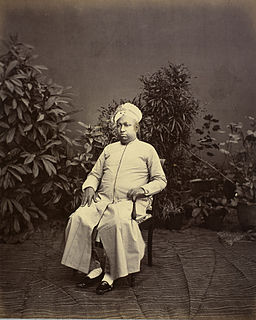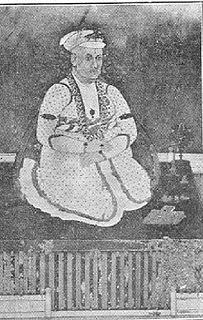| Thanjavur Subha Rao | |
|---|---|
| Diwan of Travancore | |
| In office 1830–1837 | |
| Monarch | Swathi Thirunal |
| Preceded by | T. Venkata Rao |
| Succeeded by | R. Ranga Rao |
| In office 1839 –June 1842 | |
| Monarch | Swathi Thirunal |
| Preceded by | T. Venkata Rao |
| Succeeded by | Krishna Rao |
Thanjavur Subha Rao (also known as Subharao Tanjavarkar) was an Indian administrator and musician who served as the dewan of the state of Travancore in the 1830s.

The Kingdom of Travancore (Thiruvithamkoor) was an Indian kingdom from 1500 until 1949. It was ruled by the Travancore Royal Family from Padmanabhapuram, and later Thiruvananthapuram. At its zenith, the kingdom covered most of modern-day central and southern Kerala with the Thachudaya Kaimal's enclave of Irinjalakuda Koodalmanikkam temple in the neighbouring Kingdom of Cochin, as well as the district of Kanyakumari, now in the Indian state of Tamil Nadu. The official flag of the state was red with a dextrally-coiled silver conch shell at its center. In the early 19th century, the kingdom became a princely state of the British Empire. The Travancore Government took many progressive steps on the socio-economic front and during the reign of Maharajah Sri Chithira Thirunal Balarama Varma, Travancore became the second most prosperous princely state in British India, with reputed achievements in education, political administration, public work and social reforms.
Subha Rao was a native of Thanjavur and was born into a Thanjavur Marathi Deshastha Brahmin family. He was so fluent in English that he was also known as "English" Subha Rao. He tutored the Maharaja of Travancore Swathi Thirunal in Sanskrit, Marathi, political science and Carnatic music. In 1830, he was appointed Dewan of Travancore. [1]
Thanjavur Marathi, are a Marathi-speaking ethno-linguistic group, who reside in the central and northern parts of the Indian state of Tamil Nadu. They are the descendants of Marathi administrators, soldiers and noblemen who migrated during the rule of the Thanjavur Maratha kingdom. Thanjavur was a Maratha kingdom in Tamil Country, until the British dethroned the last Thanjavur Maratha king. It was founded by Maratha Warrior King Chatrapati Shivaji's brother, Venkoji Rajē Bhonsalē. Kshatriyas and Brahmins both use the name Deshastha.
Deshastha Brahmins are a Hindu Brahmin subcaste mainly from the Indian state of Maharashtra and northern area of the state of Karnataka. The word Deshastha derives from the Sanskrit deśa and stha (resident), literally translating to "residents of the country". The valleys of the Krishna and the Godavari rivers, and a part of Deccan plateau adjacent to the Western Ghats, are collectively termed the Desha – the original home of the Deshastha Brahmins.

Svāti Tirunāḷ Rāma Varma was the Maharaja of the Kingdom of Travancore, British India. He is also considered as a brilliant music composer and is credited with over 400 classical compositions in both Carnatic and Hindustani style.










